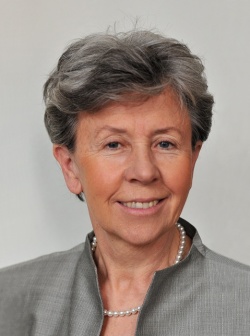Educate patients about the radiologist’s role in their treatment
15:30–16:45
Session 2
Concerns: What can be done about the lack of young radiologists in Europe?
Prof. Małgorzata Szczerbo-Trojanowska, Chairman of the Department of Radiology and Head of the Department of Interventional Radiology, University Medical School; Lublin/PL
'What can we do about the lack of young radiologists in Europe?’ ECR 2010 congress president Professor Małgorzata Szczerbo-Trojanowska will discuss the background to this shortage and suggest ways to avert this occupational crisis, although pointing out that the problem does not exist in Poland.

She has been highly active in efforts to develop interventional radiology, co-founding the Interventional Radiology Section of the Polish Medical Society of Radiology, heading it for a decade, presiding over its 2001 congress and serving as the Society’s President for three years. She also co-founded the Polish Society of Magnetic Resonance.
Education is a keen interest; on the CIRSE Board (2005-2007) she chaired the Rules Committee and helped set up the first ESIR courses in Eastern Europe. She is also a Steering Committee Member of the European School of Radiology (ESOR).
With a focus on vascular interventions, her scientific publications and presentations are numerous, and honours include the Medal of the Polish Chamber of Physicians, the President’s Award of the American Association for Women Radiologists, and honorary memberships of six radiological societies.
‘Even with many junior doctors going abroad to work in other European countries, we still don’t experience a physician shortage. However, we cannot rule out the possibility that this alarming trend will also affect Poland in the future.’
‘The reasons for a lack of junior radiological staff are manifold. One is that radiology is increasingly becoming a sophisticated discipline covering the whole field of medicine. This means we must continuously expand our clinical knowledge to become equal partners with our clinical colleagues. Moreover, imaging procedures increasingly split up into additional areas, such as molecular, cellular, genetic or functional applications. Nearly 70% of those imaging procedures performed by today’s radiologists did not exist 30 years ago. The introduction of new imaging technologies incited the great demand for radiological services. Statistics show that the number of imaging procedures performed in in- and out-patient departments are increasing over 10% every year. This leads to a tremendous workload resulting in a tremendous need for more radiologists.’
Aren’t most of the technical processes carried out automatically?
‘Yes, but this makes the situation even worse. Today, with sectional imaging techniques going automatic, we acquire hundreds of images every five minutes. We are trapped in a kind of vicious circle, having more and more data and fewer and fewer experts to read them. We acquire hundreds of images every five minutes. We are trapped in a kind of vicious circle, having more and more data and fewer and fewer experts to read them and extract vital information and draw relevant conclusions. Therefore, the main shortage is not of radiologists, but of radiological experts. It has been discussed many times that other medical disciplines rush into medical imaging. If we want to compete against those “amateur” radiologists, we have to offer better services -- we must be excellent.’
Such excellence is not always well paid. What effects does the pressure on healthcare systems have on radiologist recruitment?
‘It’s one more reason why we face this shortage, especially in the hospital. Young radiologists quickly discover that they can earn more money and have more flexible working hours in the out-patient business, which is why imaging centres pop up on virtually every street corner. But this has also to do with a different attitude in young radiologists. Being ECR president in 2010 gave me the opportunity to meet young generations of radiologists from different countries. I really learned that they see the job in a different light. They put more emphasis on a private life kept separated from the working life -- and I agree with that. But this also means they are not willing to work a 60- or even 80-hour week, or stressful night shifts as in previous generations. Consequently, when an old radiologist in an out-patient department retires we have to fill that vacancy with two young radiologists to cover the same workload.
‘There’s probably no easy way out of the situation. However, the ESR is paying a lot of attention to these problems. The Society has passed at least two actions of great importance lately -- initially promotion among young medical students. Since 2008, the Vienna congress also focuses on addressing student doctors who haven’t yet decided on a specialisation. In 2010, we invited nearly 800 young people and this year the number will probably double. A lot of these participants are visiting ECR for the second time because they are fascinated by the field. There will be special scientific sessions for medical students on 5th March, which will also be a great opportunity for us to learn about how those young people experience radiology from their viewpoint.
‘The second worthy ESR action is an awareness campaign for the general public. We have to make radiology more visible, because what our discipline really suffers is a significant underestimation of the role, value and responsibility of the radiologist in patient outcome.
‘About 40 % of patients think that the radiologist just chooses the right imaging modality and is not involved in treatment processes. 30 % of patients even believe that a radiologist isn’t part of the medical team at all. To a certain extent, this is due to our referring clinician colleagues who do not educate the patient about who else is involved in healthcare delivery.
‘So I think it was an excellent idea of ESR to organise the 1st European Day of Radiology on 11th February. In Poland the event was a great success in various media, such as TV and the press. I really believe in the power of media to bring the field of radiology forward.’
11.02.2011











